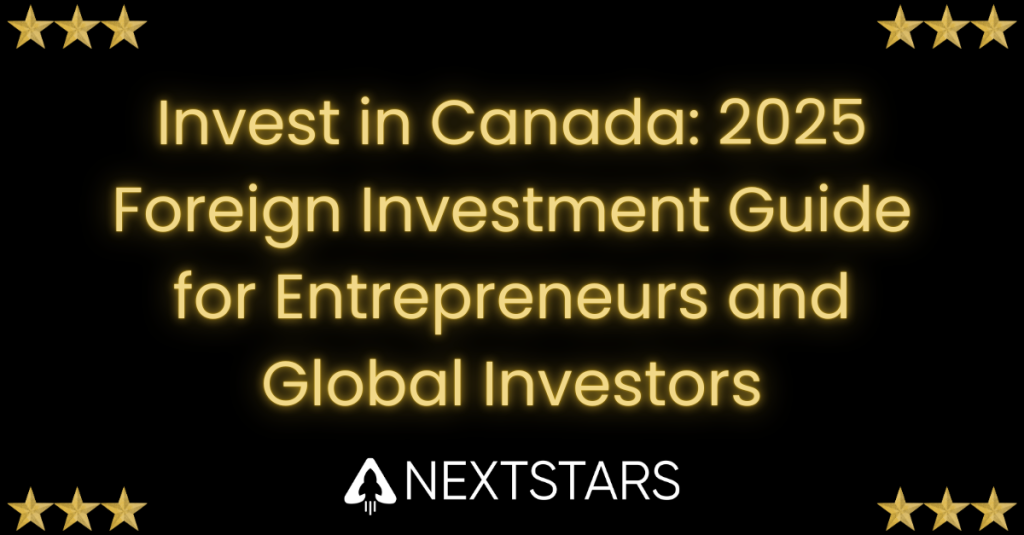By Saeed Zeinali, Founder & CEO, NextStars
While analyzing global startup ecosystems for NextStars’ international expansion strategy, I discovered something remarkable: India’s innovation economy isn’t just recovering, it’s transforming into something that could reshape global entrepreneurship. And Canada is perfectly positioned to capture this opportunity.
India’s venture capital ecosystem just posted a stunning recovery, with funding surging to $13.7 billion in 2024, a 1.4x increase from 2023. But this number only tells part of the story. What we’re witnessing is the emergence of India as the third pillar of global innovation, alongside the United States and China, creating unprecedented opportunities for Canadian entrepreneurs, investors, and organizations like NextStars that bridge global innovation ecosystems.
As someone who has built NextStars from the ground up, supporting over 200 startups through comprehensive acceleration programs, I’ve learned that the biggest opportunities emerge when complementary ecosystems connect. India and Canada represent exactly this type of complementary pairing.
The Innovation Tsunami: Why This Changes Everything
The scale of India’s transformation defies conventional understanding. India now hosts over 1.81 lakh (181,000) recognized startups as of July 2025, up from just 1.59 lakh at the start of the year. That’s more new startups in six months than Canada produces in five years.
But here’s what makes this relevant for Canadian stakeholders: Deal volumes jumped from 880 in 2023 to 1,270 in 2024, with 95% being small and medium-ticket deals under $50 million. This isn’t about a few mega-deals inflating statistics. It’s about a broad-based innovation economy creating opportunities across every sector and stage.
The geographic distribution is equally important. 49% of recognized startups now emerge from tier-2 and tier-3 cities, not just Bengaluru or Mumbai. This democratization of innovation creates multiple entry points for Canadian organizations looking to engage with India.
The Perfect Storm: Three Forces Aligning for Canada-India Innovation
Through my work developing NextStars’ international strategy and building relationships across global innovation ecosystems, I’ve identified three converging forces that make this the optimal moment for Canada-India collaboration:
1. The Policy Revolution
India eliminated angel tax, reduced long-term capital gains tax rates, removed the National Company Law Tribunal process requirements, and simplified foreign venture capital investor registrations. These aren’t minor adjustments; they’re fundamental reforms that remove the biggest barriers to international investment.
Meanwhile, bilateral trade between Canada and India reached $23.66 billion in 2024, with both countries committing to relaunch the Canada-India CEO Forum in early 2026. The political will for deeper economic integration exists at the highest levels.
2. The Capital Bridge Already Exists
Indian companies have invested over CAD 6.6 billion in Canada, employing approximately 17,000 people across eight provinces. This bidirectional flow of capital creates natural partnership opportunities. Indian companies are looking for North American market access and innovation partnerships, exactly what Canadian organizations can provide.
3. The Human Infrastructure
With 1.8 million Canadians of Indian origin and 392,810 Indian students in Canada as of 2024, we have unparalleled human bridges between these ecosystems. This diaspora understands both markets, navigates both cultures, and can facilitate partnerships that others would struggle to build.
Sector Deep Dive: Where Canadian Expertise Meets Indian Scale
Climate Technology: The Trillion-Dollar Imperative
India’s commitment to net-zero by 2070, combined with immediate air quality and water crises, creates massive demand for climate innovation. Consumer technology, which includes sustainable solutions, attracted $5.4 billion in funding in 2024, a 2.3x increase from 2023.
At NextStars, our focus on climate-conscious acceleration aligns perfectly with this opportunity. Canadian cleantech expertise in renewable energy, water treatment, and sustainable agriculture can address India’s challenges while achieving global scale. The companies that crack India’s sustainability challenges will have solutions for the entire developing world.
The AI Revolution: Beyond Outsourcing
Software and SaaS, including generative AI, attracted $1.7 billion in 2024, with AI funding alone growing 1.5x. But this isn’t about India as a back-office for AI development. Indian companies are building AI solutions for uniquely Indian problems: multilingual NLP for 22 official languages, AI for agriculture affecting 600 million people, and healthcare AI for resource-constrained environments.
Canadian AI research excellence, particularly from the Vector Institute and Mila, combined with India’s implementation capabilities and massive data sets, creates opportunities for AI innovation that neither country could achieve alone.
Quick Commerce and Digital Infrastructure
India’s digital public infrastructure is revolutionary. UPI processes over 10 billion transactions monthly, creating a cashless economy at a scale China and the US haven’t achieved. Quick commerce emerged as the breakout theme of 2024, driven by rapid customer adoption and demonstrated paths to profitability.
Canadian logistics technology, supply chain expertise, and cold chain innovations can leverage this digital infrastructure to build solutions that work in dense, complex markets. The lessons learned in India’s quick commerce revolution will define global commerce for the next decade.
The NextStars Strategy: Building Bridges, Not Just Investments
At NextStars, we’ve supported over 200 startups through comprehensive programs that go beyond traditional acceleration. Our approach to India isn’t about parachuting in with capital; it’s about building sustainable bridges that create value for both ecosystems.
Phase 1: The Talent Exchange
Before investing a dollar, we’re focusing on talent circulation. Through partnerships with Indian accelerators and universities, we’re creating programs where Indian entrepreneurs can access Canadian markets while Canadian startups can tap into Indian talent and market insights.
This isn’t brain drain; it’s brain circulation. Entrepreneurs who understand both markets become natural bridges for future collaboration.
Phase 2: The Innovation Corridor
We’re developing specialized programs that help Indian startups establish North American presence through Canada’s Startup Visa Program while maintaining Indian operations. Key collaboration areas include technology transfer, innovation, agriculture, mobility of skilled workers, and investment.
Conversely, we’re helping Canadian startups establish innovation centers in India, accessing talent and markets while maintaining Canadian headquarters. This bidirectional flow creates the foundation for long-term collaboration.
Phase 3: The Ecosystem Play
Rather than competing with established Indian VCs, we’re positioning NextStars as the bridge between ecosystems. We provide:
- For Indian startups: Access to North American markets, Canadian government programs, and global investors
- For Canadian startups: India market entry support, talent partnerships, and access to Indian investors
- For investors: Curated deal flow from both markets with built-in cross-border expansion potential
The Opportunity Cost of Inaction
While we deliberate, others are moving. Peak XV Partners invested in 47 potential unicorns in India in 2024. Major global VCs have raised massive India-focused funds: Peak XV with $2.5 billion, Nexus with $700 million, Elevation with $670 million.
But here’s the critical insight: these funds focus primarily on growth-stage investments. The early-stage ecosystem, where accelerators and venture studios create the most value, remains underserved. This is where Canadian organizations can establish dominant positions.
Moreover, five new unicorns emerged in 2024 compared to just two in 2023, signaling the return of high-growth success stories. The companies we partner with today will be the unicorns of 2030.
The Practical Playbook: How to Start
Based on my experience building NextStars and analyzing successful cross-border innovation bridges, here’s a practical approach for Canadian organizations:
For Accelerators and Venture Studios
- Start Virtual: Launch online programs for Indian startups targeting Canadian markets. Test demand and build relationships before physical expansion.
- Partner, Don’t Compete: Collaborate with Indian accelerators rather than establishing standalone operations. Share deal flow, expertise, and resources.
- Focus on Bridges: Your value isn’t in competing with local players; it’s in connecting ecosystems. Be the bridge, not another local player.
For Investors
- Follow the Diaspora: Partner with Indian-origin Canadian investors who understand both markets. They’re your best scouts and advisors.
- Think Beyond Returns: Early investments in India are about learning and relationships. The financial returns come from the second and third funds.
- Sector Focus: Don’t spray and pray. Choose sectors where Canadian expertise creates genuine value-add.
For Corporations
- Innovation Partnerships: Before acquiring or investing, partner with Indian startups for innovation projects. Learn the market through collaboration.
- Talent Strategy: Establish innovation centers in India not just for cost but for accessing different thinking and approaches to problems.
- Market Entry: Use startup partnerships to test and enter Indian markets with lower risk than traditional expansion.
The Government Catalyst: Unprecedented Support
The Indian government has allocated over $2.3 billion (INR 21,276 crore) in funding through various Startup India schemes. This isn’t just capital; it’s systematic ecosystem building that international partners can leverage.
Key programs Canadian organizations should understand:
- Startup India Seed Fund: Grants up to ₹20 lakh for proof of concept, prototype development, product trials, market entry, and commercialization
- Tax Holidays: Three years of income tax exemption for certified startups
- IP Support: 80% reduction in patent filing costs with government covering facilitator fees
These programs reduce risk for international partners while maintaining upside potential.
The Warning Signs: What Could Go Wrong
Not everything is perfect. High-profile failures like BYJU’s, which saw its valuation slashed by over 95%, remind us that India’s market can be unforgiving. The lessons:
- Unit Economics Matter: Growth at all costs doesn’t work in India. Sustainable business models are essential.
- Local Context is Critical: Solutions that work in developed markets often need fundamental reimagination for India.
- Patience is Essential: Exit timelines are longer. Public markets accounted for 76% of exit value in 2024, but IPO preparation takes years.
The Call to Action: The Time is Now
The Canada-India innovation bridge isn’t a future opportunity; it’s a present imperative. The ecosystems are aligning, capital is flowing, and early movers are already establishing positions.
At NextStars, we’re committed to being architects of this bridge. Our experience supporting over 200 startups, combined with our focus on climate-conscious innovation and immigrant entrepreneurship, positions us uniquely for this opportunity.
But this isn’t just about NextStars. It’s about Canada’s position in the global innovation economy. We can either watch as India becomes the third pillar of global innovation, or we can be active participants in its rise, creating value for both nations.
The companies we help build today, bridging Canadian innovation with Indian scale, will define the global economy of 2030. The climate solutions developed for India’s challenges will address global sustainability. The AI innovations built on India’s digital infrastructure will transform how technology serves billions.
The Final Word: From Vision to Action
India’s $13.7 billion venture ecosystem isn’t just a market opportunity; it’s a gateway to the future of global innovation. The question isn’t whether to engage, but how quickly and strategically we can build meaningful bridges.
The playbook is clear: start with talent, build through partnerships, focus on complementary strengths, and commit for the long term. The organizations that execute this playbook today will be the architects of tomorrow’s global innovation economy.
As I continue building NextStars into a truly connected global entrepreneurship ecosystem, India represents not just a market but a laboratory for the future of borderless innovation. The lessons we learn, the partnerships we build, and the companies we help create will define the next chapter of global entrepreneurship.
The bridge between Canadian innovation and Indian dynamism is being built. The only question is: Will you be among its architects or its observers?
Read our blogs here.
Ready to explore India’s innovation opportunities? Connect with NextStars to learn how we’re building bridges between Canadian expertise and Indian scale. The next wave of global innovation is emerging, and Canadian organizations have a crucial role to play.
Saeed Zeinali is the Founder and CEO of NextStars, a Toronto-based global venture studio and accelerator that transforms immigrant entrepreneurs’ ideas into climate-conscious global companies. NextStars has supported over 200 startups through comprehensive 12-24 month programs providing technical development, business model design, and strategic acceleration.





